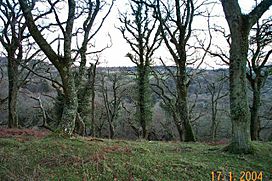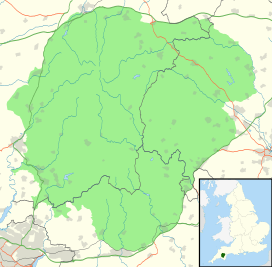Dendles Wood facts for kids
Quick facts for kids Dendles Wood |
|
|---|---|
 |
|
| Map | |
| Geography | |
| Location | Devon, England |
| OS grid | SX6161 |
| Coordinates | 50°26′N 3°57′W / 50.43°N 3.95°W |
| Area | 50.4 hectares (124.5 acres) |
Dendles Wood is a special forest area located on the southern edge of Dartmoor in Devon, England. It's a protected woodland, mainly filled with oak and beech trees. This wood is part of the larger Dartmoor Special Area of Conservation (SAC), which means it's a very important place for nature in Europe. It's also a Site of Special Scientific Interest (SSSI) and 30 hectares of it have been made a national nature reserve. Dendles Wood is one of five woodlands in Dartmoor that have this special protection. Sometimes, Dendles Wood and the nearby Hawns Wood are called Hawns and Dendles together. This forest is home to many different plants and animals that are typical for upland oakwoods. It's especially known for its wide variety of mosses and lichens, and for being a nesting place for several bird species.
Contents
Where is Dendles Wood?
Dendles Wood is found on the southern edge of Dartmoor. It covers the slopes of a valley where Broadall Lake and Ford Brook meet the River Yealm. The wood is about 3 kilometers north of a village called Cornwood. This village is the closest place to stop if you're traveling by car or bus to visit the wood. In total, Dendles Wood covers about 50.4 hectares (which is about 124.5 acres). The River Yealm flows right through the middle of the wood. You can find a path that goes through the nearby Hawns Wood and leads out onto the open moorland.
The wood is located at a height of between 160 meters (525 feet) and 280 meters (919 feet) above sea level. The ground beneath the wood is mostly made of granite rock, with some slate in the southern parts.
Animals and Plants of Dendles Wood
Plants in the Wood
Dendles Wood is a great example of an upland oakwood. Most of its trees are pedunculate oaks. However, there are also many beech trees, especially on the east and south-west sides. Beech trees are not usually found naturally in other parts of Dartmoor. You can also find a few types of shrubs growing throughout the wood. These include the common hazel, European holly, and rowan.
Just like other upland oakwoods in Dartmoor, Dendles Wood has a cool, moist, and well-lit environment. This makes it a perfect place for many different mosses and lichens to grow. Natural England, a group that protects nature, keeps an eye on the lichens here. This is because two very rare types of lichen grow in Dendles Wood: Graphina ruiziana and Cetrelia cetrarioides. Graphina ruiziana is found more here than anywhere else in the South West of England. Some more common lichens in the wood are Parmelia laevigata and Usnea florida. For mosses, you can find Rhytidiadelphus squarrosus and Thuidium tamariscinum. Other types of moss, like Isothecium myosuroides, Dicranum scoparium, Polytrichum formosum, and Plagiothecium undulatum, grow on the rocks.
Animals in the Wood
Dendles Wood is home to a group of barbastelles, which are one of Britain's rarest types of bat. These bats were first found here in 2002. Even though they were discovered after the Dartmoor Special Area of Conservation was created, experts think they will soon be officially recognized as an important feature of the site.
Many different bird species that usually live in upland oakwoods can be seen nesting in Dendles Wood. These include the common buzzard, wood warbler, redstart, and pied flycatcher. You can also spot the white-throated dipper and grey wagtail nesting near the rivers that flow through the woodland. There's a special program that puts up nestboxes for the pied flycatcher in Dendles and other Dartmoor woodlands to help them breed.
Some types of butterflies found in the woods are the silver-washed fritillary and green hairstreak. You might also see Red deer and fallow deer, as they often visit the area.
History of Dendles Wood
Dendles Wood is a very old forest. Records from Blachford Manor show that the wood was once called 'Daniels'. This name probably came from a past landowner. 'Dendles' is most likely a changed version of this old name. For much of its history since the Middle Ages, the wood was used for coppice. Coppicing is a way of cutting trees so they grow back from the stump. This was especially important when tin mines on Dartmoor were active. The oak wood from coppicing was used to make charcoal, which was needed for smelting (melting metal). By the end of the 1800s, the mining industry slowed down, and there wasn't much need for coppice products anymore. So, Dendles Wood stopped being used for this purpose.
After that, Hawns and Dendles, which was part of the Blachford Estate, became a popular place for tourists. It was open to the public on Mondays, Wednesdays, and Saturdays. Around the year 1900, the United Devon Association called it "one of the most charming sylvan spots in the whole of Devonshire."
In the 1930s, the Dartmoor Hunt, a group that hunted, would also pass through Dendles Wood.
In October 1965, the Nature Conservancy bought about 29 hectares (72 acres) of the wood. They did this to create the Dendles Wood National Nature Reserve. Since then, access to the Dendles Wood reserve has been limited. You need a permit from the Natural England Site Manager to enter. There are also rules about animals like livestock; they are not allowed in the wood. This is because too much grazing in the past had harmed the smaller plants and shrubs. In 1986, the wood was officially named a Site of Special Scientific Interest (SSSI). Later, parts of the nearby Hawns Wood and High House Moor SSSI were added to it.
Dendles Wood in Literature
In his 1909 novel The Three Brothers, the Dartmoor author Eden Phillpotts wrote about Dendles Wood:
In the glen beneath spread Dendles Wood, with fringes of larch and pine hiding the River Yealm and spreading a verdant medley of deep summer green in the lap of the grey hills.


